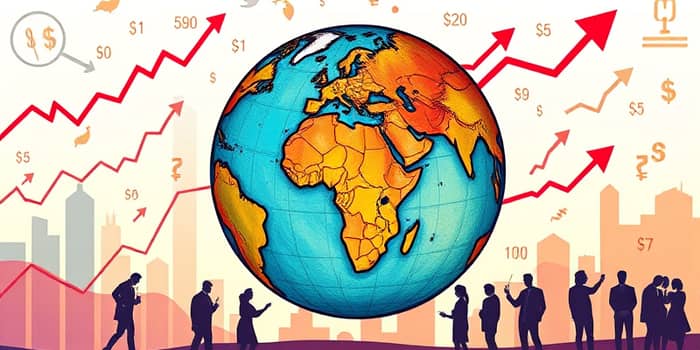As economies around the world navigate the aftermath of a historic pandemic, inflation remains a top concern for policymakers, businesses, and consumers alike. After peaking at nearly 9% in late 2022, global consumer price indexes have moderated but continue to run well above pre-pandemic levels.
Forecasts for 2025 suggest a further deceleration in price increases, yet notable regional disparities and persistent forces may keep inflationary pressures elevated into 2026. By examining the data, drivers, and risks, readers can gain critical insight into global economic dynamics and prepare for a landscape that remains uncertain.
This article explores official projections, regional variations, underlying causes, and potential pitfalls ahead. It concludes with practical implications for decision-makers and everyday households striving to protect purchasing power.
Global Forecasts and Macroeconomic Outlook
International institutions agree that headline inflation will fall in 2025. The IMF projects a projected global inflation rate of 4.2% next year, easing further to 3.5% in 2026. Other estimates cluster between 3.5% and 4.4%, reflecting broad confidence in a gradual disinflation path.
The OECD anticipates that G20 inflation will decline from 3.8% in 2025 to 3.2% in 2026, although core measures—stripped of volatile food and energy components—may remain stubbornly above 2% targets in many advanced economies.
Global GDP growth is similarly expected to slow modestly, from 3.2% in 2024 to 3.1% in 2025, easing further to 3.0% by 2026. Slower investment and cautious consumer spending underlie this moderation.
Regional Variations and Divergent Paths
Despite a unified downward trend, inflation outcomes in 2025 will differ markedly by region. Advanced economies generally move closer to central bank targets, while many emerging and developing markets continue to battle high price increases.
In advanced markets, easing supply constraints and moderate energy prices help temper inflation, yet sticky service sector inflation due to wages keeps headline rates above ideal levels. Conversely, many emerging markets face imported inflation from weaker local currencies fueling imported inflation and elevated domestic demand.
Persistent Drivers Shaping Inflation
Several core forces will underpin price dynamics in 2025. While some pressures are easing, others remain entrenched and capable of stalling further disinflation.
- Normalizing post-pandemic pressures and supply chain stability as factories ramp up output.
- Lower global food and energy prices helping moderate overall inflation rates.
- Sticky service sector inflation due to wages in tight labor markets.
- Escalation of trade protectionism raising tariffs and disrupting established supply lines.
- Tight monetary policy effects dampening demand in credit-sensitive sectors.
Food and energy prices have trended downward from mid-2022 peaks, but supply shocks related to geopolitics can reverse gains rapidly. High interest rates across many central banks have slowed consumer borrowing and investment, though the lagged impact may continue well into 2026.
Meanwhile, policy choices such as currency pegs and subsidies in the Middle East and North Africa will keep headline figures artificially low, masking underlying volatility. In Sub-Saharan Africa, double-digit inflation in Eastern and Northern regions underscores the challenge of managing local currency weakness.
Risks and Uncertainties on the Horizon
The outlook for global inflation is subject to multiple upside risks, any of which could stall or reverse the anticipated disinflation path. Understanding these uncertainties is crucial for mitigating potential shocks.
- Persistent policy uncertainty after major elections in key economies, especially the United States.
- Heightened geopolitical tensions triggering supply shocks, such as conflicts in energy-producing regions.
- Weaker local currencies fueling imported inflation in vulnerable emerging markets.
- Fiscal policy divergence extending inflation pressures where stimulus measures remain expansive.
Trade policy also looms as a wildcard. If new US tariffs on Chinese imports materialize, global growth could slow by 0.5 percentage points in 2025 and by 1.3 points in 2026, with significant inflationary spillovers.
Implications for Policymakers and Consumers
Central banks face a delicate balancing act: easing rates too quickly risks reigniting inflation, while holding policy too tight undermines growth and employment. The Federal Reserve may opt for a gradual approach, whereas the European Central Bank could pivot sooner if euro-area data soften.
For households and businesses, expectations management becomes vital. In regions with high inflation, locking in fixed-rate financing, diversifying income sources, and adjusting budgets to account for continued price pressures are practical steps to safeguard real purchasing power.
Conclusion
In 2025, the world economy stands at a crossroads between sustained disinflation and potential fresh price shocks. Although headline rates are set to fall, they will remain elevated relative to the pre-pandemic benchmark for years to come.
By closely monitoring regional variations, understanding core drivers, and preparing for downside risks, policymakers, investors, and families can navigate a complex environment. Armed with these insights and strategies, stakeholders will be better equipped to manage the challenges and opportunities of a shifting inflationary landscape.
References
- https://www.imf.org/en/Publications/WEO/Issues/2025/01/17/world-economic-outlook-update-january-2025
- https://www.imf.org/en/Publications/WEO
- https://www.focus-economics.com/blog/global-inflation-rates/
- https://www.oecd.org/en/data/insights/statistical-releases/2025/03/consumer-prices-oecd-updated-5-march-2025.html
- https://www.euromonitor.com/article/global-economic-outlook-q1-2025
- https://www.ifo.de/en/facts/2025-01-14/economic-experts-survey-q4-2024-experts-expect-inflation-remain-high-until-2028
- https://www.ey.com/en_us/insights/strategy/global-economic-outlook
- https://www.oecd.org/en/publications/2025/03/oecd-economic-outlook-interim-report-march-2025_47a36021.html










